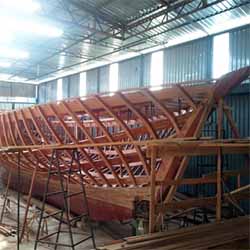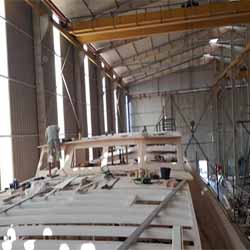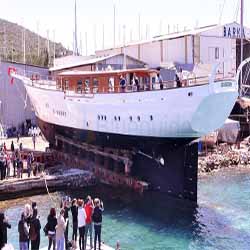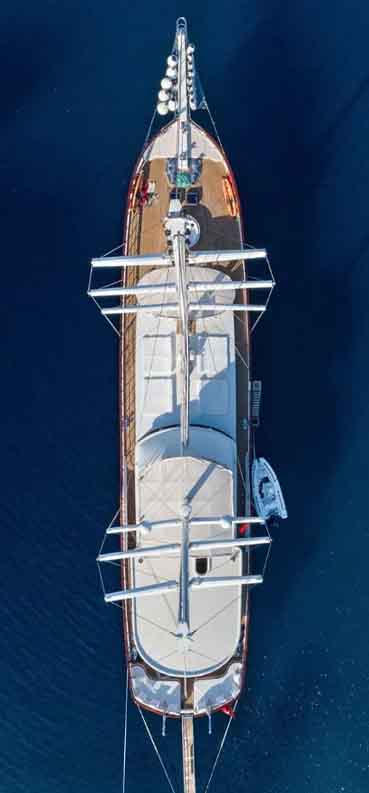Gulet Building in Turkey Discover The Ancient Art
Gulet World specializes in gulet building in Turkey, merging centuries-old craftsmanship with modern luxury. Explore bespoke, sustainable gulets crafted by master artisans.
Gulet building in Turkey with Turkish culture continues a legendary tradition that was first established in the Bodrum, Marmaris, and Bozburun coastal areas through the traditional skills of expert shipbuilders.



Turkish Gulet Building
Choose Gulet World, where Turkish tradition, innovation, and passion converge to craft gulets that sail beyond expectations.

Gulet World, Masters of Gulet Building in Turkey, Crafting Legacy on the Waves
As a master gulet building in Turkey company, Gulet World honours both the tradition of building gulets along with its historical significance. The torchbearers of gulet building in Turkey practice their art on the coastline where the Aegean and Mediterranean seas meet in a brilliant display of blue waters while drawing their inspiration from centuries of Ottoman craftsmanship and Anatolian spirit. Each boat built by our team reflects centuries of experienced craftsmanship as well as maritime innovation and wild maritime spirit.
Gulet Building Merges Traditions of the Past with Precision Techniques
Gulet building in Turkey represents a sacred union of expertise and deep respect in Turkish maritime culture. Our master ustas (artisans), heirs to generations of shipwrights, hand-select Anatolian hardwoods—dense oak, lustrous mahogany, and golden teak—sourced sustainably from Turkey’s ancient forests.
The ancient shipbuilding techniques employed for every hull include trenail-fastened plank construction, steam-bent frame fabrication, and oakum caulking from organic oak sources. Our company at Gulet World maintains tradition-based shipbuilding techniques and implements contemporary naval engineering standards to give our gulets the ability to move through water smoothly and beautifully.
Why Gulet World Stands Apart
The company originates from Turkey’s maritime heritage by embedding traditional Seljuk woodwork with Lycian nautical shapes and Cappadocian handmade brass window frames into every vessel.
Solar-powered deck features and hybrid power systems operate alongside personalised wooden ship interiors and mother-of-pearl-decorated walnut panelling.
Your Vision, Forged in Wood: Private owner or charter pioneer? Gulet World designs every feature, which starts with custom stern work and includes concealed technology spaces to create a boat that matches your business goals.
Sustainability: The Heart of Gulet Building in Turkey
Gulet World makes its dedication to building gulets in Turkey endure past the watery realm. Gulet World joins forces with Turkish forestry cooperatives that replant trees after each keel lay and choose reclaimed timber materials for ecosystem preservation. Our shipyard performance includes ancient herb ceremonies and waste-free milling operations because we promise to guard the sites that motivate us.
From Shipyard to Horizon
The vessels created by Gulet World maintain their status as living memories. Once you enjoy Turkish coffee served on your olive resin-treated teak deck, you can see Lycian ruins while crew members tell stories of Ottoman trading days. Gulet World presents Turkey’s unmatched combination of historical significance and luxury sailing experiences that you will only find through their services.
Join the Legacy
Gulet World transforms boat construction into the art of creating ocean sanctuaries that inscribe life memories into each wooden component of production. Experience our personal gulet construction services to find your dreams afloat with Turkish gulet building tradition.
Read our reviews about Gulet building in Turkey
Whispers of the Ancients: The Alchemy of Gulet Building in Turkey
The process to create a gulet starts in Turkey’s Turquoise Coast twilight coves with a blessing rather than with construction tools. Before their creation begins, gulets emerge through a spiritual connection that unites water-loving builders with universal forces while selecting destroyable wood fragments as well as shaping their dynamic seaworthy forms.
The Keel: A Pact with the Divine
As the first woodcutting operation commences, the usta gathers dawn break with elders to conduct deniz duası, which serves as a sea blessing. During the keel ritual, Usta members pour lamb’s milk mixed with honey over the keel wood while praying to Poseidon and Umman Baba for their divine blessing. The keel comes from aged Anatolian black pine wood which absorbs mountain snowwater before the usta carves nazar symbols into it for protection from evil intentions. Ustas claim the keel acquires its special curvature from the spine of diving dolphins, which ancestors received in their dreams.
Wood’s Secret Language
Coming from a spiritual background, the wood receives various sacred events before it arrives at the shipyard. Located in sacred Myanmar forests, the teak wood is harvested during a waning moon phase to maintain its spirit and subsequently immersed in saltwater lagoons where it ages for many years, absorbing essential minerals that give it an appearance like flowing liquid amber. The prow section receives mahogany because its wood grains portray the appearance of storm waves, indicating that the material maintains oceanic recollections. The usta plays his ney flute near the edges of the wood to generate Ottoman makams that ease each plank during its shaping process.
The Dance of the Trenails
The hulls receive no modern nails to attach them together. Pieces of wooden juniper that oil-soaked treenails originate from are carefully driven into holes previously bored into the ship. The containment of the ship becomes absolute when seawater causes the hull to expand against the trenails because they then spread throughout the vessel. Maritime experts apply the ancient naval technology çivi tanrıları (“nail divinities”) through the method that originated with Byzantine dromons. Shark skin treatment of trenails exists as apprentice knowledge that requires a nerve test when apprentices swear on the Kitab-ı Bahriye (Book of Navigation).
The Devil’s Hourglass
During midnight hours when shipyard silence prevails, the usta conducts şeytan saat (“devil’s hour”), which remains against regulations. The components for this mixture consist of crushed pumice combined with beeswax and myrrh, which shipwrights from Genoa stole from the 14th century for hull seam applications. Legend has it that this alchemical process enables galleys to move through storms smoothly as a dagger would penetrate silk.
Living Cabins: Where Geometry Breathes
The cabin areas beneath the deck break free from standard Euclidean shapes. The walls of the cabins feature a spiral seashell pattern, which initially came from Seljuk mosques to help lovers whisper secrets to each other. The ceiling panels contain mother-of-pearl inlays that show the summer sky patterns of the Aegean Sea. Muska talismans with Quranic verses wrapped in silk rest inside the drawers to protect against stormy weather. The doorknobs made from Corinthian bronze have a distinct octopus shape, which serves as a tribute to the ocean intelligence.
Sails Stitched with Stars
A sunset-orange colour emerges from sailing fabric made of Egyptian cotton when walnut husks and pomegranate rinds are used to dye it. The sail embroidery features a mühr-ü Süleyman sealing (Seal of Solomon) in gold thread to protect against sailing delays. The Phoenician code used to knot the hemp rigging yields the latitude for ancient Troy once its hidden cypher is unravelled because the ropes have been treated in pine tar during boiling.
The Maiden Voyage: A Sea Bride’s Adornment
The gulet gets pomegranate-adorned to welcome its maiden voyage with a rooster comb placed atop for the purpose of wind-awakening. The bow anointing ritual uses rose attar, which village women apply while children throw coins from the year of keel-laying. The usta’s firstborn daughter takes a living seagull from its cage while the boat kisses the water surface. It is customary to fill the hours of celebration until dawn with raki mixture from the shipwright’s garden, combined with deniz kadayıfı seaweed pastries to tame atmospheric temperaments.
The Gulet’s Second Life
The essence of a genuine gulet lives on since it undergoes reincarnation. Weary old gulet ship hulls become boutique hotel buildings within the cobblestoned Bodrum streets where once were cabins that now serve as luxurious velvet-suited living spaces. The transformed wooden masts function as vineyard trellis systems, allowing the wine production for şarap, which guests enjoy beneath the original Meltemi-wind-supporting beams.
Epilogue: The Shipwright’s Epitaph
Upon death, all tools belonging to Usta are placed inside cedar wood boxes and submerged at sea, but his adze remains displayed at the shipyard as a protective item. Before their initial cut, new apprentices immediately touch the adze to receive the fabled “salt in his veins.” The skill of gulet buildig requires the master to seek an eternal conversation instead of pursuing absolute excellence in his work. Every gulet expresses hidden elements from the shipbuilder’s hard work together with the wood’s lunar attraction and oceanic bitterness through time. Boating aboard such a ship connects you to the essence of history while time disappears within its rhythmic contours.
Have Questions About Gulet Building? Get In Touch!
Please feel free to contact us using the form below or via WhatsApp. Our friendly team is here to provide you with all the information and support you need. We look forward to hearing from you about gulet building in Turkey!
